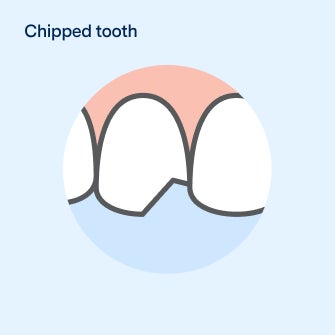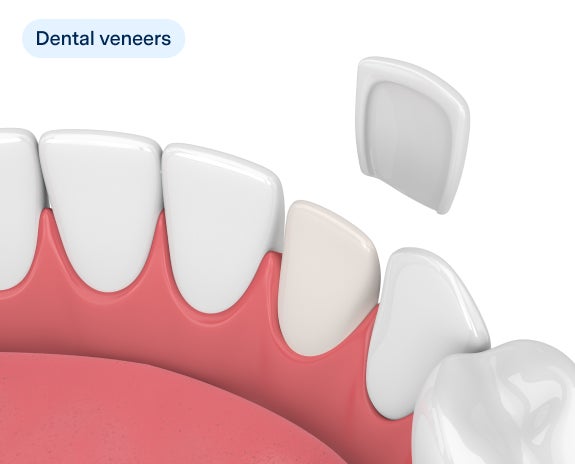Last updated 10.07.2024
How to fix a chipped tooth
Chipped tooth? Discover repair options and costs at Aspen Dental to restore your bright smile quickly and affordably.

Discovering a chipped tooth can be alarming, but there's no need to worry. Chipped teeth are the most common dental injury, and there are effective treatments to restore your radiant smile. Whether you've experienced a minor chip or a significant break, knowing how to handle it and the available options can make all the difference.
What is a chipped tooth?
A chipped tooth occurs when a small piece of the tooth enamel breaks off, leaving a jagged edge or an obvious gap. This can happen for various reasons and is more common than you might think. While it may be uncomfortable, a chipped tooth is typically not a dental emergency, and there are several ways to manage it until you can see a dentist.

What are the causes of chipped teeth?
Chipped teeth can result from various situations. Some common causes include:
Biting down on hard objects like ice, nuts, or hard candy.
Minor accidents such as falls or sports injuries.
Bruxism or teeth grinding, especially during sleep.
Weak enamel due to poor dental hygiene or dietary habits.
Understanding these causes can help you take precautions to prevent future chips and injuries.

Types of chipped teeth
Chipped teeth, while common, vary widely in terms of severity and treatment required. Depending on the kind of damage they've sustained, chipped teeth can fall into several distinct categories, each presenting its own challenges and treatment methods:
Craze lines
Craze lines should be addressed proactively. Think of it like a small chip in your windshield—if left untreated, it’s only a matter of time before it expands, and dental restoration may not be possible. Additionally, if craze lines appear around an existing restoration, neglecting them can lead to cusp fractures. Taking action early can help maintain your dental health and prevent further issues down the line.
Fractured cusp
This type of chip occurs when a piece of the tooth's chewing surface breaks off. It most commonly affects molars, the teeth primarily used for grinding food. While a fractured cusp can weaken the tooth, it doesn't typically affect the pulp and, therefore, doesn't usually cause much pain. Repair might involve a root canal and placing a crown or an onlay to restore the tooth's shape and functionality.
Cracked tooth
A more serious condition, a cracked tooth, features a crack that extends from the chewing surface vertically towards the root. Symptoms can vary widely, from zero symptoms at all to severe pain when chewing, especially when releasing the biting pressure. Treatment is necessary to prevent further damage and might involve a dental crown or root canal therapy, depending on how close the crack extends to the nerve.
Split tooth
This is a progression of a cracked tooth where the crack extends deep enough to split the tooth into two separate parts. A split tooth is usually the result of an untreated cracked tooth and often results in the tooth being unable to be saved. Tooth extraction is commonly required, followed by tooth replacement options such as dental implants or bridges to restore function and aesthetics.
Each type, from the minor craze lines to the more severe split tooth, requires a unique approach to ensure the tooth's health, functionality, and appearance are maintained or restored.

2 emergency tips for treating a chipped tooth
While treatment for chipped teeth can sometimes be delayed, this kind of dental fracture typically requires emergency care. While you wait to see your dentist, following these tips can help prevent further damage:
Avoid chewing on the affected side
To avoid exacerbating the chip or inducing discomfort, it's advisable to refrain from chewing on the side of your mouth where the chipped tooth is located. This can help prevent the chip from worsening or causing pain while eating.
Cover any sharp edges
Covering any sharp edges of the chipped tooth with dental wax or sugarless gum can offer immediate relief. This temporary solution protects the soft tissues in your mouth, such as your tongue and the inner cheeks, from cuts and irritation caused by the rough edges of the tooth.
Taking these steps can help you manage discomfort and protect your mouth until you receive professional care.
How to fix a chipped tooth
Fixing a chipped tooth depends on several factors, including the degree of damage and the location of the break. Here are some common procedures:
Dental bonding
Dental bonding involves applying a tooth-colored resin to the affected area and shaping it to match the natural tooth. This process is quick, minimally invasive, and ideal for minor chips. Learn more about dental bonding.

Dental veneers
Veneers are thin shells of porcelain or composite resin that cover the front surface of the tooth. They are perfect for larger chips or when you want to improve the overall appearance of your smile. Learn more about dental veneers.

Dental crowns
Crowns cover the entire tooth, offering protection and restoring function. This option is suitable for more severe chips or fractures. Learn more about dental crowns.

Dental fillings
Fillings are used when the chip has resulted in a cavity or significant tooth decay. The dentist removes the decayed portion and fills the gap with a composite material. Learn more about dental fillings.

Root canals
If the chip exposes the tooth's pulp, causing pain or risk of infection, a root canal may be necessary. This procedure removes the damaged pulp and seals the tooth, often followed by a crown. Learn more about root canals.

Cost of repairing a chipped tooth
The cost of fixing a chipped tooth varies depending on the treatment method and additional factors like tests and anesthesia. Here's a general cost breakdown for nationwide averages:
Dental bonding: $100 - $400 per tooth
Dental veneers: $500 - $1,500 per tooth
Dental crowns: $800 - $1,500 per tooth
Dental fillings: $50 - $150 per tooth
Root canals: $700 - $1,200 per tooth
For detailed pricing, check out our pages on veneers cost, root canal cost, dental fillings cost, and dental crowns cost.
How to prevent chipped teeth
Prevention is always better than cure. Here are some strategies to avoid chipped teeth:
Wear a mouthguard
Wear a mouthguard during sports or any activities that pose a risk of impact to your face. This simple tool can be a major safeguard against dental injuries.
Avoid chewing on hard objects
Avoid the habit of chewing on hard objects such as ice cubes, pens or hard candy. These can exert undue pressure on your teeth, leading to chips or cracks.
Maintain good dental hygiene
Maintain excellent dental hygiene by brushing twice a day and flossing once a day. This keeps your enamel strong, which is your teeth's first line of defense against chips and other damages.
Implementing these practices can save you time, money and discomfort in the long run. Taking these small steps to protect your teeth can help preserve your smile and avoid emergency trips to the dentist.

Your chipped tooth questions answered
What is the difference between a chipped and cracked tooth?
A chipped tooth typically occurs when a minor piece of the enamel breaks away, often due to biting down on something hard, an accident, or general wear and tear. It may not cause pain unless the chip exposes the sensitive layers beneath the enamel.
On the other hand, a cracked tooth involves a more serious condition where a fracture line extends through the tooth. This crack can vary in depth, sometimes reaching all the way to the root. This type of damage often results from pressure from grinding or clenching teeth, a significant impact or sudden temperature changes. A cracked tooth can lead to more severe pain and sensitivity issues, and if the crack reaches the root, it may require more complex treatment, like a root canal, to save the tooth.
Does insurance cover a chipped tooth repair?
It's a common question with a nuanced answer. Generally, most dental insurance plans do provide coverage for basic repair work, such as fillings, which are often required for minor chips. However, the extent of the coverage can differ significantly when it comes to more comprehensive treatments like crowns or veneers, which might be necessary for larger chips or cracks. The specifics of what is covered will depend on your individual insurance plan, and it's always a good idea to consult with your insurance provider to understand the details of your coverage. At Aspen Dental, we accept most insurance providers.
Is it okay to leave a chipped tooth?
It's highly advisable to schedule an appointment with your Aspen Dental dentist at the earliest opportunity when dealing with a chipped tooth. Ignoring it and leaving it untreated can not only result in further deterioration of the tooth itself but can also pave the way for more serious issues, such as infections that could affect your overall oral health. Prompt dental care can prevent the situation from worsening and prevent the tooth from further chipping to the extent it cannot be repaired.

Restoring your smile at Aspen Dental when you need it
Chipping a tooth can happen to anyone, but it's not the end of the world. With modern dental treatments, restoring your smile is easier than ever. From dental bonding to veneers and crowns, there are solutions for every type of chip at Aspen Dental. Remember, prevention is key, but when accidents happen, knowing your options can make all the difference.
If you're dealing with a chipped tooth, don't wait—schedule an appointment or walk-in for emergency dental services at your local Aspen Dental office. Your smile deserves the best care, and we're here to provide it.



